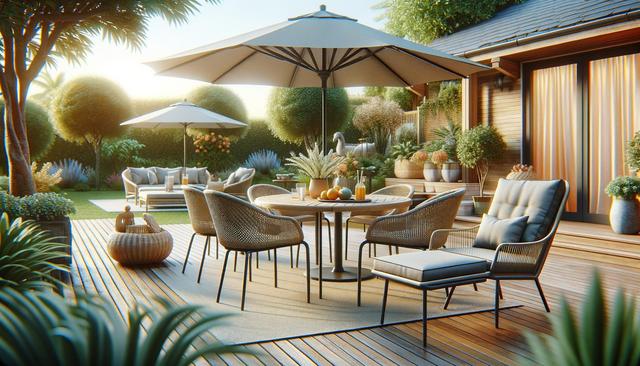Creating Comfort Outdoors: A Guide to Choosing Patio Furniture
Outdoor living spaces are becoming more popular, and patio furniture plays a key role in making them both functional and inviting.

Understanding the Purpose of Your Patio Space
Before selecting patio furniture, it’s important to define how you plan to use your outdoor area. Whether you’re setting up a space for dining, lounging, entertaining, or all of the above, your furniture choices should align with those goals. For example, a dining set with a spacious table and multiple chairs works well for hosting meals, while a sectional sofa might be more suitable for relaxed gatherings.
Consider your typical activities and the number of people you expect to accommodate. If you enjoy hosting, prioritize seating and table space. For quiet evenings alone or with a partner, compact and cozy furniture may be more appropriate. Understanding your needs will guide the type, size, and quantity of furniture you should invest in.
Some helpful questions to ask include:
- Do you need space for outdoor dining or casual lounging?
- Will the area be used primarily by family, guests, or both?
- How much space is available, and what layout fits best?
Answering these questions will help narrow down your options and ensure your patio space is as practical as it is enjoyable.
Materials Matter: Choosing the Right Construction
The material of your patio furniture significantly impacts its durability, maintenance needs, and overall aesthetic. Popular materials include wood, metal, plastic, and wicker, each offering its own set of advantages and considerations. Weather resistance is a key factor, especially if your furniture will be exposed to sun, rain, or snow.
Here are a few common materials and their features:
- Wood: Offers a classic look and solid construction. Requires regular treatment to prevent weather damage.
- Metal: Durable and sleek, often powder-coated to resist rust. Can become hot in direct sunlight.
- Wicker: Lightweight and stylish, ideal for covered areas. Synthetic wicker is more weather-resistant than natural.
- Plastic/Resin: Affordable and low-maintenance, though sometimes less sturdy.
When choosing materials, balance appearance with practicality. If you live in a region with fluctuating weather, opting for materials that require minimal upkeep while still looking attractive over time can save both effort and money.
Comfort and Functionality: Going Beyond Aesthetics
While style is important, comfort and functionality should not be overlooked. Outdoor furniture should be as enjoyable to use as it is to look at. This means choosing pieces with ergonomic design, adequate cushioning, and features that support your intended use, such as adjustable backrests or extendable tables.
Cushions and upholstery play a big role in comfort. Look for outdoor-rated fabrics that resist fading, moisture, and mildew. Removable covers are a bonus for easy cleaning. Chairs with armrests and loungers with headrests can enhance relaxation, especially during long periods of use.
Functionality also includes furniture that serves multiple purposes. For example, ottomans can double as extra seating or storage. Folding or stackable chairs make it easier to store pieces during off-seasons or larger events. Features like built-in umbrellas or fire pit tables can further elevate convenience and ambiance.
Design and Layout: Making the Most of Your Space
Effective design and layout can transform even small patios into inviting retreats. Start by measuring your available space and sketching a layout that includes furniture, walkways, and any additional elements like planters or grills. Leave enough room for people to move comfortably between pieces without feeling cramped.
Choose furniture that complements the scale of your space. In compact areas, opt for streamlined designs or modular sets that can be reconfigured as needed. In larger areas, consider zoning the space with different furniture groupings—such as a dining area and a separate lounge corner—to create a sense of structure and purpose.
Color and texture also contribute to the overall feel. Neutral tones offer versatility, while bold colors can add personality. Mixing materials—like pairing a metal table with wooden chairs—can create visual interest. Don’t forget to include outdoor rugs, lighting, and accessories to complete the look.
Maintenance and Longevity: Keeping Your Furniture Looking Great
Investing in patio furniture means considering how to care for it properly to extend its lifespan. Regular maintenance varies by material but generally includes cleaning, protective treatments, and proper storage. Furniture covers can help protect pieces from weather and UV exposure when not in use.
Here are some general maintenance tips by material:
- Wood: Clean with mild soap and water, apply sealant annually.
- Metal: Wipe down regularly, check for rust spots and touch up paint as needed.
- Wicker: Vacuum or brush gently to remove debris, clean with a damp cloth.
- Plastic: Hose down or wipe with soapy water, avoid abrasive cleaners.
Seasonal storage is also essential. If possible, move furniture indoors during winter months or use weather-resistant covers. Stacking or folding chairs can save space and reduce wear. Well-maintained furniture not only looks better but also provides a safer, more enjoyable environment for years to come.